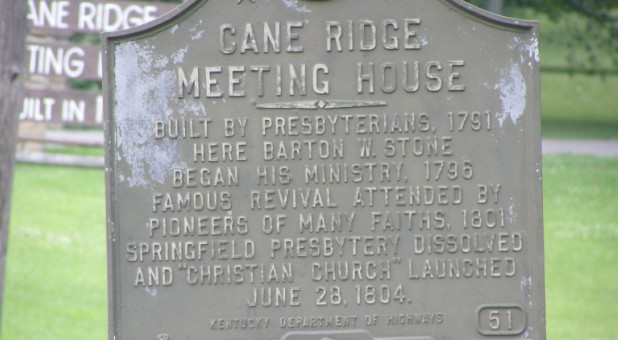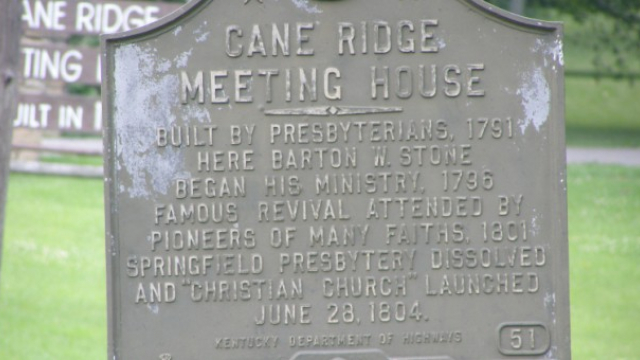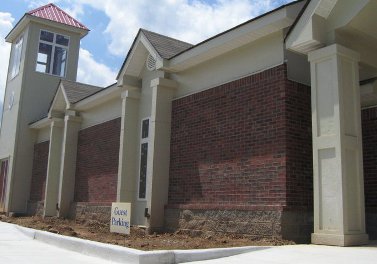Click to join the conversation with over 500,000 Pentecostal believers and scholars
Click to get our FREE MOBILE APP and stay connected
| PentecostalTheology.com




The GREAT HOLY GHOST CANE RIDGE REVIVAL of 1796
One of those great revivals of the American past took place in the late spring and early summer of 1801 at Cane Ridge in central Kentucky. A pastor named Barton Stone, who had been called to serve this little Methodist church by Daniel Boone, decided to call a four-day meeting for personal renewal and revival.
The members of the Cane Ridge church and most of the people around them were farmers and since the crops had been planted and they were waiting on the harvest at the end of the summer willingly laid down their plows for this meeting. At that May meeting there were many in that local church that begin to experience what was called “the fullness of the Spirit” or as later Methodist and holiness preachers would call it “perfect love.” We can read accounts of what took place and understand it as they were receiving the Holy Ghost evidenced by speaking with tongues.
Since the May meeting had gone so well, Barton Stone and his small church decided that they would host another meeting in August that would be just before the harvesting of their crops. The only difference this time was that this little church had now spent about 2 ½ months in revival and the word begin to leak out about what was taking place. As the word spread in the surrounding communities, people came from everywhere. So many came that the United States Army had to come in to help with managing the crowds. The U.S. Army did their own count and said there were 20,000 who came to this Cane Ridge revival meeting.
The little church could seat at its maximum capacity only about 250 people and so the overflow spilled out into several pastures and pulpits were put up so that people could hear the Word and then respond in the old-fashioned altars.
James Finley, who was converted and would later become a circuit-riding Methodist preacher, described the scene in his personal journal:
The noise was like the roar of Niagara. The vast sea of human beings seemed to be agitated as if by a storm. I counted seven ministers, all preaching at one time, some on stumps, some on wagons, and one was standing on a tree which had, in falling, lodged against another. . . Some of the people were singing, others praying, some crying for mercy in the most piteous accents, while others were shouting most vociferously. While witnessing these scenes, a peculiarly-strange sensation, such as I had never felt before, came over me. My heart beat tumultuously, my knees trembled, my lips quivered, and I felt as though I must fall to the ground. A strange supernatural power seemed to pervade the entire mass of mind collected there. . . I stepped up on to the log, where I could have a better view of the surging sea of humanity. At one time I saw at least five hundred swept down in a moment, as if a battery of a thousand guns had been opened upon them, and then immediately followed shrieks and shouts that rent the very heavens. (From James Boles, The Great Revival, 1787-1805.)
It was not too long after this that the entire American frontier blazed with revival. Peter Cartwright, another Methodist circuit-rider, came to the fore-front of the revival scene and God was pouring out His Spirit on those ‘shoutin’ Methodist and holiness preachers and people. It was during this time that the camp meetings began their ascent in the history of the American churches.
-All revivals have a price tag on them. They are not cheap nor do they come easy. They require great devotion and personal sacrifice.
* Revivals bring the Church back to prayer.
* Revivals return the Church to a hunger for the Word of God.
* Revivals jolt the Church from spiritual stagnation and deadness of heart.
* Revivals stimulate the Church to heart-felt, sincere worship.
* Revivals bring the Church to place of intercessory agony that is marked by tears and travail.
* Revivals cause commitment to holiness and separation from the world.
* Revivals fill the Church with passion and godly desire.
* Revivals fill the Church with a reformation of mind and heart.
(From a sermon by Philip Harrelson, The Battlefield of Prayer, 8/6/2010)



Asbury Revival 2023 Goes on… | Pentecostal Theology
[…] The GREAT HOLY GHOST CANE RIDGE REVIVAL of 1796 […]
LEE follows ASBURY REVIVAL 2023 | Pentecostal Theology
[…] The GREAT HOLY GHOST CANE RIDGE REVIVAL of 1796 […]
Anonymous
We know that when a supposed “revival” focuses on the Holy Spirit that something is wrong.
Jesus said, “When the Advocate comes, whom I will send to you from the Father, the Spirit of truth who proceeds from the Father, He will bear witness about Me…”
True revival focuses on Christ, not the Holy Spirit.
Anonymous
Duane L Burgess you know this was a reformed calvinist revival right?
Anonymous
True revival focuses on Jesus and the Gospel, not the Holy Spirit.
Anonymous
Tony Richie August 6, 1801: Revival hits a Presbyterian camp meeting in Cane Ridge, Kentucky. Within a week, 25,000 were attending the revival services. It was the largest and most famous camp meeting of the Second Great Awakening. With extended preaching and prayer services, as well as frequent communion, it’s spiritual demonstrations and manifestations are considered precursors of the Pentecostal revival nearly a century later and continuing to the present.
https://www.pentecostaltheology.com/1796-the-foundation-of-the-great-cane-ridge-revival-of-logan-county-kentucky/
Anonymous
I grew up less than an hour from there. Never heard about it until I moved to Ohio.
Anonymous
The church started at Jerusalem ,many Jews will be converted